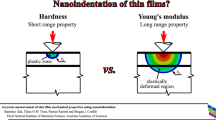Abstract
The piezoelectric films recently developed permit the design of very efficient thin sensors which are suited to interesting applications in contact problems, not only in industrial robotics but also in experimental research. After a brief introduction exemplifying the electrical principles, the primary aspects of the technique are presented and discussed with reference to possible structural engineering applications. A rather simple example regarding the interaction between a steel bar and a block of concrete is also presented. The bar is excited by dynamic cyclic loads having variable frequency. The reliability of forces detected via a PVDF sensor is evaluated by comparing the results with those obtained in parallel by means of a dynamometer strain-gauge. The comparison is promising, even if some technological problems must be resolved before this experimental technique may be applied extensively.
Resume
L'étude expérimentale des forces qui se manifestent à une interface équivaut souvent à un problème technique insoluble car chaque appareillage influe de manière significative sur le comportement mécanique. En outre, si l'interface se situe dans un continuum, l'utilisation de transducteurs ou d'extensomètres devient aussi plus complexe. Dans tous les cas, les mesures peuvent se faire éventuellement à proximité de l'interface, mais non à l'interface.
Des améliorations techniques récentes dans le domaine de la robotique permettent d'utiliser des films de polymères piézoélectriques (fluoride de polyvinylidène, PVDF). En raison de l'épaisseur de ce capteur qui ne dépasse pas quelques micromètres, le comportement mécanique n'est pas perturbé. Le principle électrique est typique du transducteur piézoélectrique: les charges crées par le film piézoélectrique sollicité sont concentrées sur les surfaces métallisées qui le recouvrent. Cette technique permet d'étudier de nombreux problèmes structurels. S'il s'agit de béton armé, par exemple, il est intéressant d'examiner la répartition de la pression sur un appui de poutre ou bien à la surface d'un boulon d'ancrage, les contraintes interfaciales aussi bien d'une barre d'armature chargée axialement et transversalement, que de goujons dans des structures composites.
Un exemple simple montre la fiabilité de la nouvelle technique: une haute barre d'adhérence enrobée dans un bloc de béton est mise sous charge dynamique. On compare la force détectée par le capteur PVDF placé à l'interface barre d'acier-barre d'enrobage avec celle qui est mesurée au moyen du dynamomètre traditionnel placé parallèlement au support. La comparaison, établie à différentes fréquences, est satisfaisante. Cependant, pour utiliser cette nouvelle technique sur une grande échelle, il convient de résoudre quelques problèmes techniques: l'améioration de la conductivité électrique des connexions entre les surfaces métallisées de la couche sensible et les fils d'entrée et de sortie la prévention d'une éventuelle perforation du film par des particules de granulats siliceux qui sont un des constituants de base des mortiers et bétons; l'évaluation de la sensibilité d'un capteur multicouches à l'écrasement inévitable du matériau à proximité d'une barre d'acier, avec une microfissuration locale et un glissement limité. La recherche se poursuit tant au niveau technologique qu'électronique.
Similar content being viewed by others
References
‘Combined experimental/analytical modelling of dynamic structural systems’ASME, AMD 67(1) (1985).
Dario, P., ‘Touch sensitivity polymer skin uses piezoelectric properties to recognize orientation of objects’,Sensor Review (October 1982) 194–198.
Idem. Dario, P., ‘Piezoelectric polymers: new sensor material for robotic application’, in Proceedings of 13th ISIR, Chicago, Illinois. April 1983, pp. 14–34.
Bauer, C., ‘PVDF polymer: ferroelectric polarization and piezoelectric properties under dynamic pressure and shock wave action’,Ferroelectrics 49 (1983) 231–240.
Broadhurst, P., ‘Physical basis for piezoelectricity in PVDF’, ibid.Ferroelectrics 60 (1984) 3–13.
Dell'Acqua, R., ‘Non-conventional applications of thick-film technology’,Hybrid Circuits No. 12 (January 1987) 11–21.
White, N. and Cranny, A., ‘Design and fabrication of thick film sensors’, ibid.Hybrid Circuits No. 12 (January 1987) 32–35.
Gatti, E. and Manfredi, P. F., ‘Processing the signals from solid-state detectors in elementary-particle physics’,Rivista Nuovo Cimento (1986).
Brandolini, A. and Gandelli, A., ‘Signal evaluation and measurement techniques in a single cell hybrid tactile sensor for large object manipulation’, in Proceedings of IMCT/90, San Jose, California, February 1990, pp. 126–131.
Utescher, G. and Herrmann, H., ‘Experimental Evaluation of the Ultimate Capacity of Smooth Round Dowels Enbedded in Concrete and Made of Austenitic Stainless Steel’ (in German), Report 346 (DAfSt, Berlin, 1983) pp. 49–104.
Dei Poli, S., Di Prisco, M. and Gambarova, P. G., ‘Dowel Action as a Means of Shear Transmission in RC Elements: a State of Art and New Test Results’, (in Italian), in ‘Studi e Ricerche’, Vol. 9-87 (School for the Design of RC Structures, Politecnico di Milano, Milan, 1988) pp. 217–303.
Furuuchi, H. and Kakuta, Y., ‘Deformation behavior in dowel action of reinforcing bars’,Trans Jpn Concr. Inst. 8 (1986) 289–294.
Pijaudier-Cabot, G., Mazars, J. and Pulikowski, J., ‘Steel-concrete bond analysis with nonlocal continuous damage’,J. Struct. Engng. ASCE 117(3) (1991) 862–882.
Author information
Authors and Affiliations
Rights and permissions
About this article
Cite this article
Di Prisco, M., Gandelli, A. A new experimental approach to the investigation of contact forces at an interface. Materials and Structures 26, 214–225 (1993). https://doi.org/10.1007/BF02472614
Issue Date:
DOI: https://doi.org/10.1007/BF02472614




